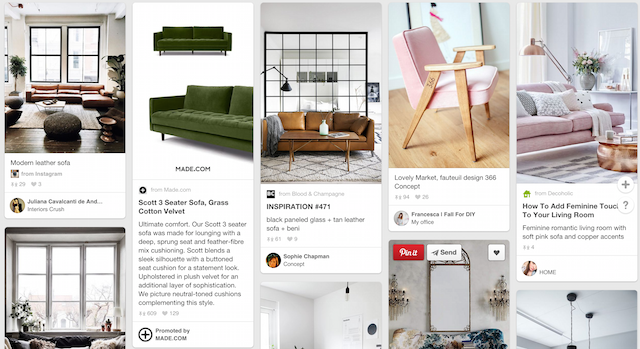It’s the right network
My colleague Jack Simpson recently wrote an article titled ‘Do you need to be on that new social media platform?‘
The thrust was that brands need not be on every network if they do not support organisational goals.
The beauty of Pinterest for MADE is in a tailor-made audience. Home decor is one of the biggest categories of pins.
Users tend to make boards to plan out considered purchases, whether it be designer furniture or their ideal wedding.
Recognising how right Pinterest was, MADE began creating its own boards in early 2012, two years after the online store had launched.
Promoted Pins are the same but different
Though MADE has only just started using Promoted Pins, it has used Rich Pins for a while.
The great thing about paid pins is that they are just about the most native form of advertising you can find on the web.
Pinterest is a naturally consumerist/materialist network, full of users coveting products, objects, styles and people. That means promoted content doesn’t jar.
Below you can see an example of one of MADE’s promoted pins displayed when I searched for ‘sofa’.
The pin stands out beautifully for its extended length and considered copy (as opposed to the average pinners’ terse descriptions).
I also like the way the brand name is surfaced again in the image itself, and the retailer must be aware that by using a white background and highlighting only the product, the pin stands out sharply from the ‘in situ’ images that surround it.

Cleverly named trend boards
Boards are created for:
- Style trends (New Nordic, Industrial)
- Different rooms or functions (Work, Sleep, Eat Live)
- Colours (Think Pink, White Hot)
- Audience types (The Dad Pad, Rented Home)
- Different brand perspectives (Meet the Team, Behind the Scenes, The Making Of)
- Seasons (Christmas, Spring)
- Events (Design Week)
This is simple but creative marketing – come up with as many interesting angles as you can and then use pithy copywriting to create catchy board titles.
Effective when done well.
Pinfluencers
MADE has collaborated with influencers, such as A Diary of Lovely (Helena del Rio).
Helena created a board for MADE as a guest pinner. MADE products did feature but so, too, did artwork (Willem de Kooning), design editorial (The Guardian) and pins from other social networks such as Tumblr.
With 40,000 followers on Pinterest (compared to MADE’S 20,000), Helena will bring visiblity to both brand and specific products.
The financial arrangement here is unclear (if there was one) and that’s potentially something that should be on the minds of brand marketers, given Google’s recent pronouncements.
User generated content
Even though Pinterest is a salesly network, and so pushing products works better than other social platforms, the honesty of user generated content is still powerful.
MADE pins photographs from MADE Unboxed, its own social network of customers that upload pictures of their own homes featuring the company’s products.
Channel integration
Knowing that large purchases can take some time in the planning, MADE isn’t shy about directing customers to Pinterest, where their research may just convince them to make a purchase.
Using Pinterest in other marketing channels, such as banners within email, is a quick way that MADE can interest its consumers with content and soften the sales message.
What’s next?
Pinterest’s advertising products are intriguing. Buyable Pins include features such as alerting users to price mark downs via email, while Cinematic Pins are a motion-based ad (a bit like a clever, and admittedly sometimes annoying, display banner).
Buyable Pins might not be right for all – much like the Buy button in Twitter, these Pins are chiefly used by retailers using a big ecommerce platform such as Shopify or Demandware.
However with MADE already seeing uplift from its organic strategy on Pinterest, there’s no reason its foray into the native ad world of Pinterest Promoted Pins won’t yield similarly good results.


Comments